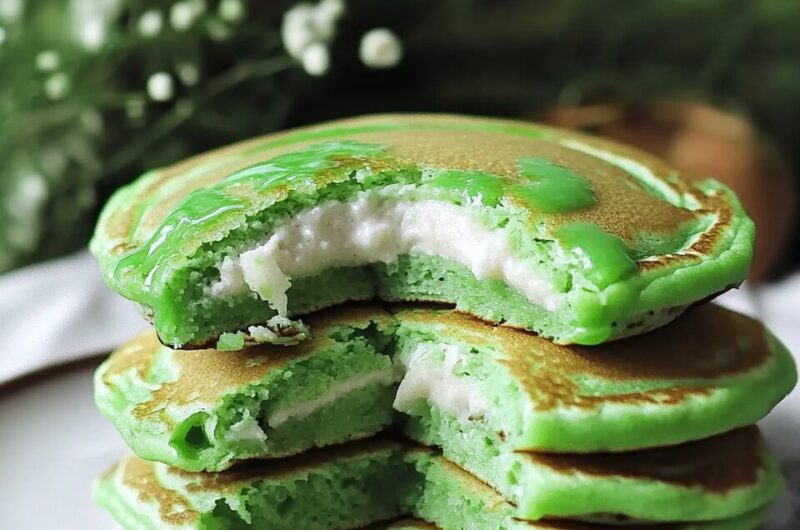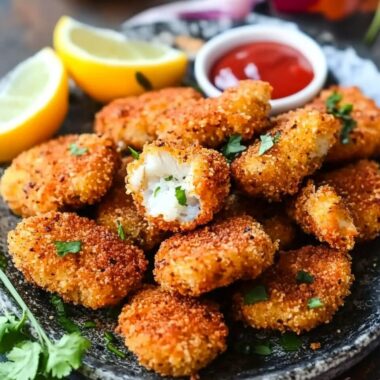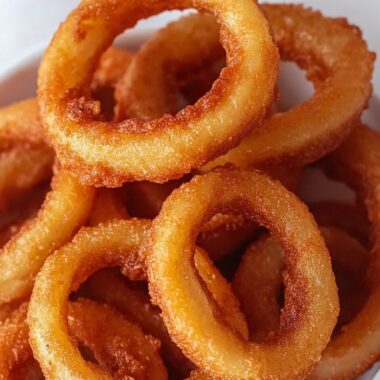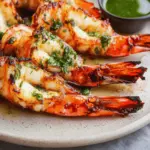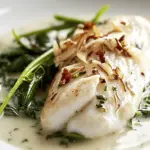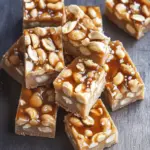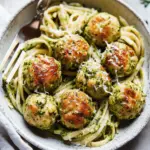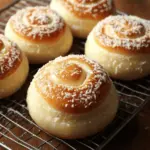These Pandan Pancakes with Coconut Custard Filling are a delightful Asian fusion treat that blends the fluffy texture of Western pancakes with the fragrant flavors of Southeast Asian pandan and coconut. The pancakes are tinted and flavored with vibrant green pandan extract, while the rich coconut custard adds a sweet, creamy contrast. Perfect for breakfast or dessert, these pancakes are as beautiful as they are delicious.
Full Recipe:
Ingredients
Pandan Pancakes
-
1½ cups all-purpose flour
-
3 tsp baking powder
-
3 tbsp granulated sugar
-
1¼ cups milk
-
1 whole egg
-
1 tsp pandan extract
Coconut Custard Filling
-
1 cup coconut milk
-
1 tbsp cornstarch
-
2 tbsp granulated sugar
-
1 whole egg
Directions
To make the pancakes:
-
In a large bowl, whisk together flour, baking powder, and sugar.
-
In a separate bowl, combine milk, egg, canola oil (optional), and pandan extract.
-
Add the wet mixture to the dry mixture and whisk until smooth and fully combined.
-
Heat a non-stick pan over medium heat and cook the pancakes until bubbles form and edges set. Flip and cook the other side until golden.
To make the coconut custard:
-
In a saucepan, mix coconut milk, cornstarch, and sugar. Heat over medium heat until it begins to simmer.
-
In a separate bowl, lightly whisk the egg.
-
Slowly pour the hot coconut milk mixture into the egg while whisking constantly to temper the egg (prevent scrambling).
-
Return the mixture to the saucepan and cook over medium heat until thickened. Remove from heat and cool.
To serve:
Stack pancakes and spoon coconut custard in between or on top. Optional: drizzle with condensed milk for extra sweetness.
Nutrients
Approximate (per serving, varies by portion size):
-
Calories: ~250–300
-
Carbohydrates: ~35g
-
Protein: ~5–6g
-
Fat: ~10–12g
-
Sugars: ~10–14g
-
Fiber: ~1–2g
-
Rich in: Vitamin C, Iron (from coconut milk), and B vitamins
The Allure of Pandan
Pandan, also known as screwpine, is a fragrant tropical plant commonly used in Southeast Asian cooking, prized for its unique aroma that is often described as a cross between vanilla, grassy freshness, and roasted nuts. It adds a natural, vibrant green hue and a distinct flavor that feels indulgent yet refreshing. In this recipe, a small amount of pandan extract transforms a standard pancake batter into something aromatic and unforgettable.
The pandan not only gives these pancakes a beautiful color and a soothing aroma but also elevates their flavor profile, making them both exotic and familiar. It’s no surprise that pandan is considered the “vanilla of the East”—an essential flavor in many beloved desserts across countries like Indonesia, Malaysia, Thailand, and the Philippines.
Fluffy Pancakes with a Tropical Soul
The pancake batter in this recipe is designed for softness and lightness. Made with everyday pantry ingredients like flour, baking powder, milk, sugar, and egg, it’s easy to whip up while delivering consistent results. The pandan extract integrates effortlessly into the wet ingredients, giving each pancake its signature green tint and floral, vanilla-like taste.
When cooked, these pancakes are light and airy with golden edges and a slight chew, offering the perfect texture to cradle the creamy coconut custard. They’re substantial enough to hold fillings and toppings yet delicate enough to serve as a dessert.
The Magic of Coconut Custard
The real indulgence of this dish comes from the rich, velvety coconut custard filling. Coconut milk, sugar, cornstarch, and egg come together to create a luscious, pudding-like cream that is slightly sweet, nutty, and silky smooth. Cooked slowly to ensure a thick and spoonable consistency, the custard makes every bite of pancake luxurious and comforting.
This custard isn’t just a filler—it’s a flavor statement. It complements the floral notes of pandan beautifully, delivering a blend of sweet and creamy textures that’s both balanced and deeply satisfying.
Perfect for Breakfast or Dessert
While these pandan pancakes are decadent enough to serve as dessert, they are light and energizing enough for a special breakfast or brunch. For breakfast, they pair wonderfully with hot tea or coffee. As a dessert, they shine when stacked high and drizzled with condensed milk or coconut syrup for extra indulgence.
Their natural sweetness also means you can enjoy them without much added sugar, making them a versatile option for different times of the day. Whether you’re treating yourself or impressing guests, these pancakes are guaranteed to delight.
A Dish That Celebrates Fusion and Heritage
This recipe is a great example of how culinary traditions from different cultures can come together to create something entirely new. The Western pancake is familiar and comforting, while the pandan and coconut custard bring strong Southeast Asian roots. Together, they create a dish that is both nostalgic and novel—familiar in format but exciting in flavor.
It’s also a great introduction to Southeast Asian ingredients for those unfamiliar with pandan. The accessibility of the recipe—using readily available pandan extract and pantry staples—makes it easy to explore new flavors from the comfort of home.
Nutrition and Balance
Each serving of pandan pancakes with coconut custard offers a moderately indulgent nutritional profile. You can expect around 250 to 300 calories, with carbohydrates for energy, a decent amount of protein from the egg and flour, and healthy fats from the coconut milk. The fiber content, while modest, can be increased by using whole wheat flour or adding a tablespoon of shredded coconut.
Coconut milk is a good source of iron, manganese, and healthy saturated fats like lauric acid, which is known for its antimicrobial and energy-boosting properties. The pandan extract, while used in small amounts, contains natural antioxidants, especially when sourced from fresh leaves.
This dish can also be adjusted to suit different dietary needs—use dairy-free milk for a fully plant-based version, or swap in a sweetener like coconut sugar or maple syrup to reduce refined sugar intake.
Serving Ideas and Presentation
The beauty of these pandan pancakes is in their versatility and visual appeal. Their vibrant green color makes them instantly eye-catching, and they can be styled in several ways:
-
Stacked high, with layers of custard between each pancake for a showstopping tower
-
Rolled like crepes, with custard inside and a drizzle of condensed milk or coconut caramel on top
-
Cut into quarters and served as a finger-friendly dessert with toothpicks
-
Topped with tropical fruits like mango, banana, or lychee for a bright finish
You can also dust them with powdered sugar, add toasted coconut flakes, or even pair them with a scoop of vanilla or coconut ice cream for a restaurant-quality dessert.
Tips for Best Results
-
Don’t overmix the pancake batter—gentle whisking helps keep them fluffy.
-
Use a non-stick pan or lightly greased skillet for perfectly golden pancakes.
-
Temper the egg properly when making the custard to avoid curdling.
-
Let the custard cool slightly before serving so it thickens to the perfect spreadable consistency.
If you’re making them ahead, the pancakes and custard can be stored separately in the refrigerator and assembled just before serving.
Conclusion
Pandan Pancakes with Coconut Custard Filling are a stunning, flavorful treat that combines the best of comfort and culture. With their eye-catching color, sweet tropical flavor, and creamy texture, they offer a beautiful way to enjoy something familiar yet new. Whether served at brunch, as a dessert, or for a festive occasion, they’re sure to leave a lasting impression.
This recipe celebrates the art of fusion cooking—drawing on Southeast Asian ingredients to reimagine a classic dish in a fresh and exciting way. With every bite, you get a taste of softness, fragrance, and a hint of exotic sweetness that makes these pancakes truly special. It’s a dish you’ll want to revisit again and again, not just for how it tastes—but for the experience it brings to your table.

